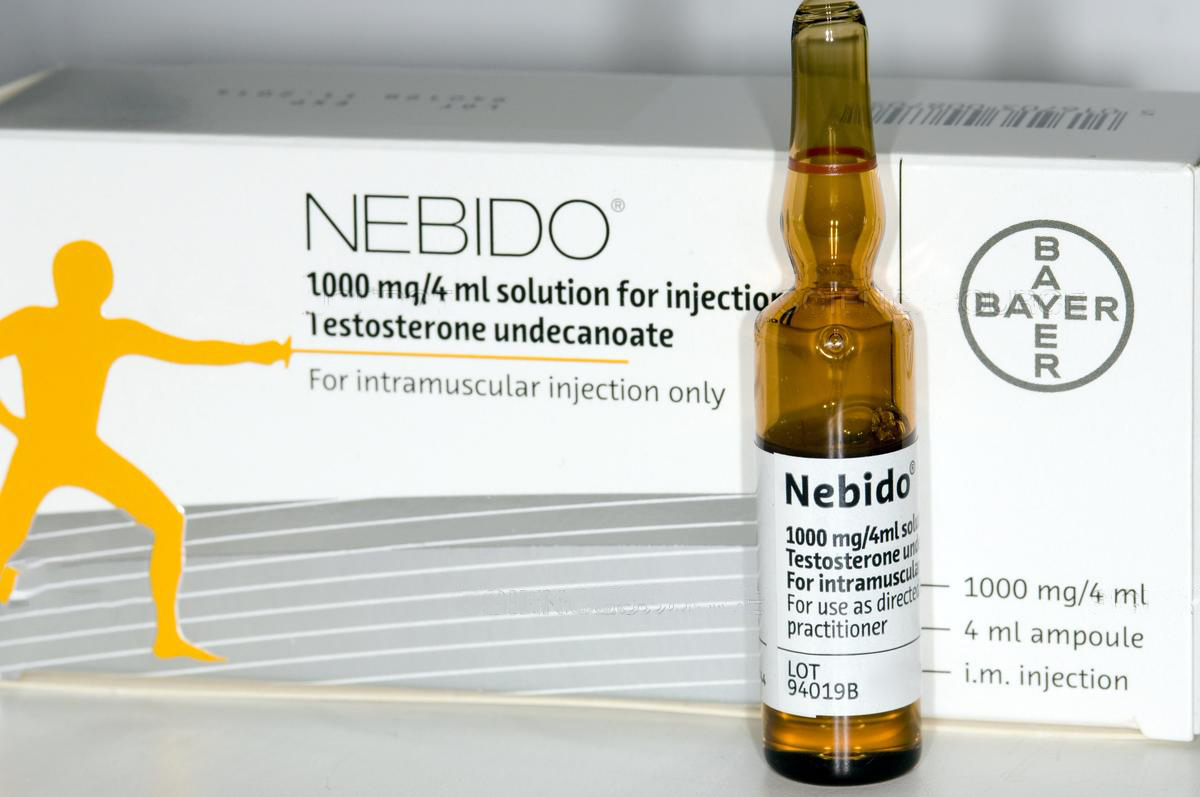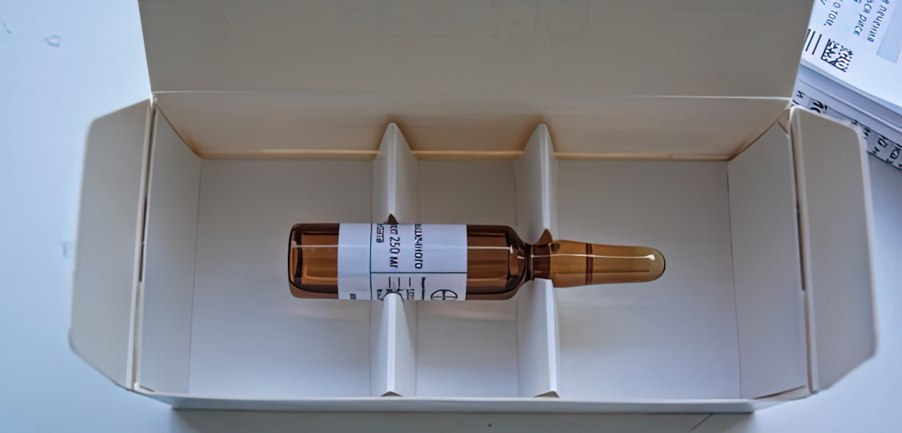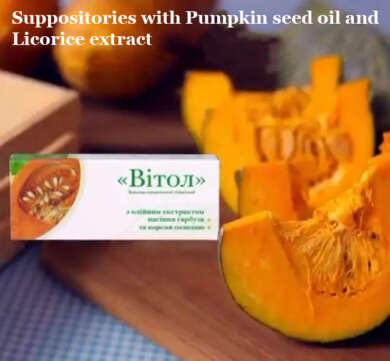Description
Buy NEBIDO Testosterone 1000mg/4ml #1 solution for injection
Description of Nebido 1000mg/4ml:
Solution for injections Nebido is used as testosterone replacement therapy for hypogonadism in men in the conditions of confirmation of testosterone deficiency clinically and by the results of laboratory studies.
Nebido is an injectable depot drug containing testosterone undecanoate; and as a result, the effect of the first pass is absent.
Ingredients:
Nebido 1000 mg/4 ml, solution for injection. 1 ml solution for injection contains 250 mg testosterone undecanoate corresponding to 157.9 mg testosterone.
1 ampoule / vial with 4 ml solution for injection contains 1000 mg testosterone undecanoate corresponding to 631.5 mg testosterone.
Pharmacodynamic Properties of Nebido 1000mg/4ml:
Testosterone undecanoate is an ester of the naturally occurring androgen, testosterone. The active form, testosterone, is formed by cleavage of the side chain.
Testosterone is the most important androgen of the male, mainly synthesised in the testicles, and to a small extent in the adrenal cortex.
Testosterone is responsible for the expression of masculine characteristics during foetal, early childhood, and pubertal development and thereafter for maintaining the masculine phenotype and androgen-dependent functions (e.g. spermatogenesis, accessory sexual glands). It also performs functions, e.g. in the skin, muscles, skeleton, kidney, liver, bone marrow, and CNS.
Dependent on the target organ, the spectrum of activities of testosterone is mainly androgenic (e.g. prostate, seminal vesicles, epididymis) or protein-anabolic (muscle, bone, haematopoiesis, kidney, liver).
The effects of testosterone in some organs arise after peripheral conversion of testosterone to estradiol, which then binds to estrogen receptors in the target cell nucleus e.g. the pituitary, fat, brain, bone, and testicular Leydig cells.
Pharmacokinetic Properties of Nebido 1000mg/4ml:
ABSORPTION. Nebido is an intramuscularly administered depot preparation of testosterone undecanoate and thus circumvents the first-pass effect. Following intramuscular injection of testosterone undecanoate as an oily solution, the compound is gradually released from the depot and is almost completely cleaved by serum esterases into testosterone and undecanoic acid. An increase in serum levels of testosterone above basal values may be seen one day after administration.
STEADY-STATE CONDITIONS. After the 1st intramuscular injection of 1000 mg testosterone undecanoate to hypogonadal men, mean Cmax values of 38 nmol/L (11 ng/mL) were obtained after 7 days. The second dose was administered 6 weeks after the 1st injection and maximum testosterone concentrations of about 50 nmol/L (15 ng/mL) were reached. A constant dosing interval of 10 weeks was maintained during the following 3 administrations and steady-state conditions were achieved between the 3rd and the 5th administration. Mean Cmax and Cmin values of testosterone at steady-state were about 37 (11 ng/mL) and 16 nmol/L (5 ng/mL), respectively. The median intra- and inter-individual variability (coefficient of variation, %) of Cmin values was 22 % (range: 9-28%) and 34% (range: 25-48%), respectively.
DISTRIBUTION. In serum of men, about 98% of the circulating testosterone is bound to sex hormone binding globulin (SHBG) and albumin. Only the free fraction of testosterone is considered as biologically active. Following intravenous infusion of testosterone to elderly men, the elimination half-life of testosterone was approximately one hour and an apparent volume of distribution of about 1.0 l/kg was determined.
BIOTRANSFORMATION. Testosterone which is generated by ester cleavage from testosterone undecanoate is metabolised and excreted the same way as endogenous testosterone. The undecanoic acid is metabolised by ß-oxidation in the same way as other aliphatic carboxylic acids. The major active metabolites of testosterone are oestradiol and dihydrotestosterone.
ELIMINATION. Testosterone undergoes extensive hepatic and extrahepatic metabolism. After the administration of radio-labelled testosterone, about 90% of the radioactivity appears in the urine as glucuronic and sulphuric acid conjugates and 6% appears in the faeces after undergoing enterohepatic circulation. Urinary medicinal products include androsterone and etiocholanolone. Following intramuscular administration of this depot formulation the release rate is characterised by a half life of 90±40 days.
Indications for use Nebido 1000mg/4ml:
- Testosterone replacement therapy for male hypogonadism when testosterone deficiency has been confirmed by clinical features and biochemical tests.
- Sport.
NEBIDO offers many benefits if it manages to successfully increase testosterone levels. These benefits include:
- Improved sexual health;
- Increase in libido;
- Enhanced mood;
- Faster metabolism;
- Increased musculature;
- Enhances all male traits.
Features of application:
The drug Nebido is not recommended for use by children and adolescents.
The drug Nebydo can be used exclusively in cases of confirmed (hypo- or hypergonadotropic) hypogonadism and only after preliminary exclusion of other potential causes of the existing symptoms. Testosterone deficiency must be clearly manifested clinically (reduced expression of secondary sexual characteristics, changes in body composition, asthenia, decreased sexual desire, erectile dysfunction) and be confirmed by two separate measurements of the level of testosterone in the blood.
Before starting testosterone therapy, all patients should undergo a thorough medical examination to rule out pre-existing prostate cancer. In patients receiving testosterone treatment, it is necessary to regularly and thoroughly check the condition of the prostate and mammary glands using generally accepted methods of examination (digital rectal examination; monitoring of the serum level of prostate specific antigen (PSA)) at least once a year or 2 times a year in elderly patients and special categories of patients (with clinical or hereditary risk factors). Consideration should be given to local principles for monitoring the safety of testosterone replacement therapy.
Contraindications for use Nebido 1000mg/4ml:
Side Effects:
Interaction with other medicinal products:
Oral anticoagulants
It has been reported that testosterone and its derivatives increase the activity of oral anticoagulants – derivatives of coumarins. Therefore, patients taking oral anticoagulants need careful monitoring, especially at the beginning and after the end of androgen therapy. It is recommended to check prothrombin time and international normalized ratio (INR) more often.
Other types of interactions
Concomitant use of testosterone with adrenocorticotropic hormone or corticosteroids can provoke the development of edema. Therefore, these drugs as concomitant therapy should be used with caution, especially in patients with heart or liver disease or patients with a predisposition to edema formation.
Impact on the results of laboratory studies
Androgens can reduce the level of thyroxine-binding globulin, which, accordingly, leads to a decrease in the total level of thyroxine and an increase in the uptake of triiodothyronine and thyroxine. However, the concentration of free fractions of thyroid hormones remains unchanged. There are no clinical signs of deterioration of the function of the thyroid gland.
Overdose of Nebido 1000mg/4ml:
No special therapeutic measure apart from termination of therapy with the medicinal product or dose reduction is necessary after overdose.
Storage:
This drug does not require any special storage conditions.
Shelf life:
5 years. The drug must be used immediately after first opening.






Reviews
There are no reviews yet.